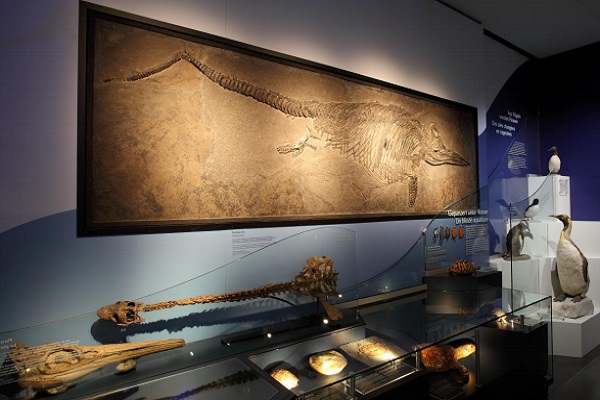 Microcleidus melusinae, a new plesiosaurian;
Credit: P. Vincent, R. Weis, G. Kronz and D. Delsate, Geological Magazine 2017
Microcleidus melusinae, a new plesiosaurian;
Credit: P. Vincent, R. Weis, G. Kronz and D. Delsate, Geological Magazine 2017
As of this month, the Luxembourg Natural History Museum (MNHNL) introduced the fossil skeleton of a plesiosaur found in the 1990s to its permanent exhibitions.
Visitors to the MNHNL- or Natur Musée- will now have the chance to see one of the most important discoveries in Luxembourg palaeontology over the last decades: the fossil skeleton of an almost entire plesiosaur, a type of marine reptile. The Luxembourg specimen was discovered during earthworks in the south of the country in the early 1990s, but was made available for scientific study only recently.
Palaeontologist Robert Weis of the MNHNL explained that the specimen had been mostly ignored over the past years until its preparation by specialist Oliver Kunze (Stuttgart) “finally revealed the exceptional nature of the piece”.
Plesiosaurs were a group of large marine reptiles that evolved during the Mesozoic era and disappeared at the end of the Cretaceous era with the dinosaurs. The first plesiosaur was discovered in the 19th century in English Dorset by the first woman-palaeontologist in history, Mary Anning. Since then only a few skeletons have been described from Jurassic layers, especially from England and Germany.
This is indeed the first discovery of an almost complete skeleton of plesiosaur in the Grand Duchy and in the border region. The study of the skeleton and the comparison with other skeletons found in layers of the same age by the palaeontologist Peggy Vincent of the National Museum of Natural History of Paris, in collaboration with a team of researchers from the MNHNL (Robert Weis, Guy Kronz and Dominique Delsate) has shown that it is also a new species. The species has been named Microcleidus melusinae in honour of Luxembourg's Melusina legend.
The entire specimen is now shown in the new permanent exhibitions of the Natur Musée where it is intended to help illustrate the evolution of marine reptiles.








